The Dal Mill Machine Market is estimated to be valued at USD 258.0 million in 2025 and is projected to reach USD 336.8 million by 2035, registering a compound annual growth rate (CAGR) of 2.7% over the forecast period.
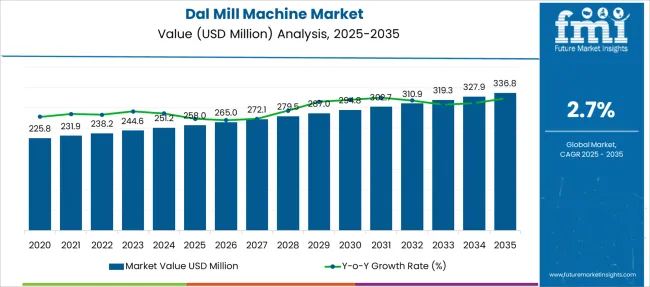
| Metric | Value |
|---|---|
| Dal Mill Machine Market Estimated Value in (2025 E) | USD 258.0 million |
| Dal Mill Machine Market Forecast Value in (2035 F) | USD 336.8 million |
| Forecast CAGR (2025 to 2035) | 2.7% |
The Dal Mill Machine market is witnessing stable expansion, supported by the rising demand for automated and high-efficiency milling solutions across the agricultural sector. The current market scenario reflects increasing mechanization among small and medium-scale agro-processing units, driven by growing consumer demand for processed pulses and favorable government initiatives aimed at modernizing food production infrastructure.
As highlighted in company press releases and agriculture technology news, advancements in milling precision, energy efficiency, and reduced grain loss are contributing to greater machine adoption. Future outlook remains optimistic, supported by ongoing investment in agri-processing infrastructure and evolving food safety standards, which are encouraging millers to upgrade from traditional setups to technologically advanced machinery.
Additionally, manufacturers are focusing on modular designs and multi-purpose functionality to cater to a broader set of applications and regional requirements These developments are paving the way for sustained growth of the market, with rural modernization, energy optimization, and production scalability expected to play critical roles in shaping long-term market dynamics.
The market is segmented by Product Type, Motor Power, Application, and Mode of Operation and region. By Product Type, the market is divided into Combined Dal Milling, Mini Dal Milling, and Tractor Operated Dal Milling. In terms of Motor Power, the market is classified into 7.5 HP, 3.5 HP, 5 HP, and 10 HP. Based on Application, the market is segmented into Industrial (Agriculture) and Commercial. By Mode of Operation, the market is divided into Automated and Semi-Automated. Regionally, the market is classified into North America, Latin America, Western Europe, Eastern Europe, Balkan & Baltic Countries, Russia & Belarus, Central Asia, East Asia, South Asia & Pacific, and the Middle East & Africa.
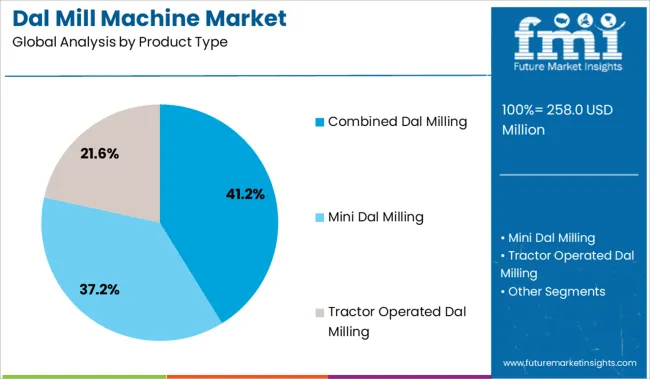
The combined dal milling segment is projected to account for 41.2% of the Dal Mill Machine market revenue share in 2025, making it the dominant product type. This leadership position is being driven by its integrated operational capabilities, which allow for cleaning, dehusking, splitting, and grading in a single workflow. Agricultural equipment news and manufacturing journals have observed that this multi-stage functionality reduces processing time and minimizes grain loss, leading to improved operational efficiency.
Combined machines are also being preferred for their compact designs and ability to support both small-scale and commercial operations. Investor presentations and trade show coverage have highlighted increasing adoption of these machines in regions with high pulse production due to their cost-effectiveness and reduced labor dependency.
The rising need for streamlined, energy-efficient processing lines has also supported the growth of this segment These factors are collectively positioning combined dal milling machines as the preferred choice among pulse processors aiming to scale up production with minimal overhead.
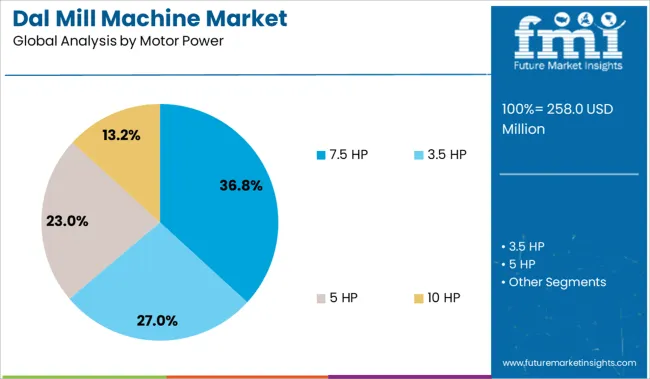
The 7.5 HP motor power segment is expected to contribute 36.8% of the Dal Mill Machine market revenue share in 2025, establishing it as a leading segment by motor power. This dominance is being supported by its suitability for medium to high-volume operations and its ability to balance performance with energy efficiency.
Reports from industrial machinery expos and product launch announcements have indicated that 7.5 HP motors are widely adopted in rural and semi-urban installations, offering sufficient power for continuous operations without excessive energy consumption. Manufacturers have been observed to standardize this motor category due to its compatibility with a broad range of processing capacities and its reliability under variable load conditions.
Additionally, its popularity is reinforced by ease of maintenance and strong aftersales service networks These operational advantages have driven sustained demand for 7.5 HP powered dal mill machines, particularly among medium-sized milling units aiming to scale operations while maintaining cost control.
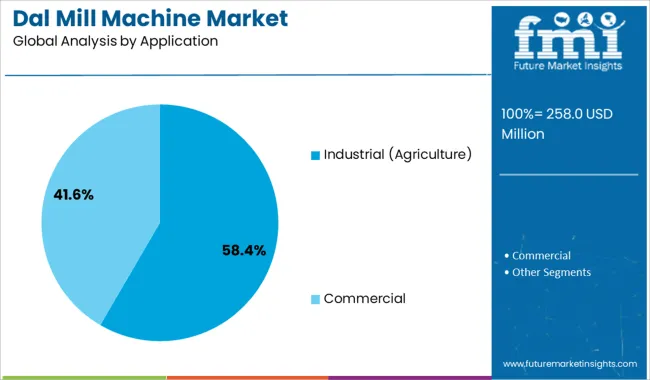
The industrial agriculture application segment is projected to dominate the Dal Mill Machine market with a 58.4% revenue share in 2025. This growth is being driven by rising mechanization in post-harvest processing and increasing investments in agri-value chains. Industry statements and agritech project updates have shown that agricultural cooperatives and medium-scale farming enterprises are prioritizing automated solutions to improve throughput and ensure consistent quality.
The demand from agro-industrial players for durable, high-output machinery that supports continuous operations has resulted in increased deployment of dal mill machines across processing hubs. Furthermore, the segment’s expansion is supported by rural development initiatives and subsidies aimed at promoting modern food processing.
Press releases from equipment manufacturers have highlighted the need for industrial-grade milling solutions to meet growing consumer demand and export quality standards The preference for application-specific designs that offer higher capacity and minimal downtime has further cemented the leadership of the industrial agriculture segment in the overall market landscape.
The global dal mill machine market is forecast to grow at a CAGR of over 2.7% between 2025 and 2035 in comparison to the 1.9% CAGR registered during the historical period from 2020 to 2025.
Growing demand for dal, particularly in developing countries, increasing use of dal in various dishes, and rising popularity of packaged and ready-to-eat foods are some of the key factors driving the global dal mill machine market.
Similarly, the growing adoption of mini dal mill machines across households and the integration of advanced technologies in dal processing equipment are expected to boost the market during the next ten years.
A number of influential factors have been identified that are expected to spur growth in the global industrial dal mill machine market during the projection period (2025 to 2035). Besides the proliferating aspects prevailing in the market, the analysts at FMI have also analyzed the restraining elements, lucrative opportunities, and upcoming threats that can somehow influence industrial dal mill machine sales.
The drivers, restraints, opportunities, and threats (DROTs) identified are as follows:
DRIVERS
RESTRAINTS
OPPORTUNITIES
THREATS
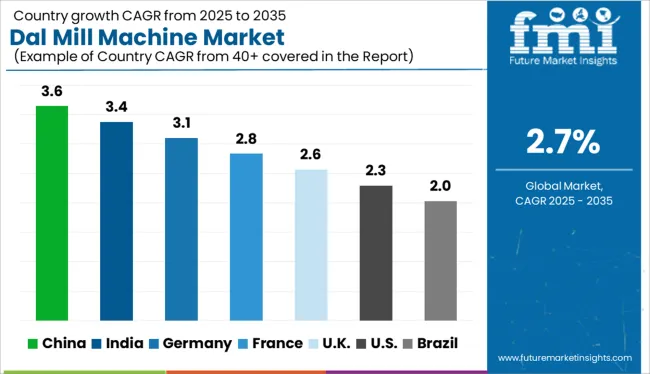
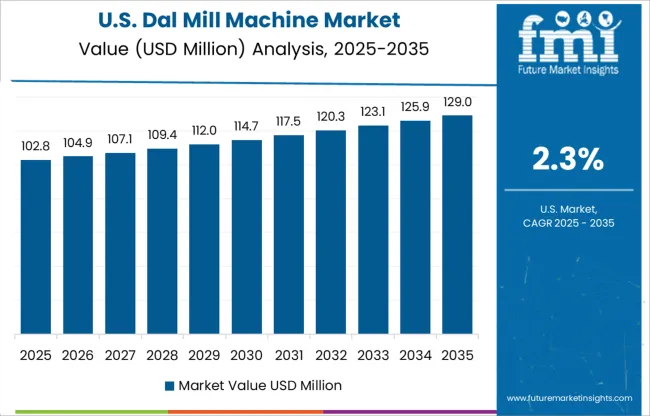
Growing Consumption of Legumes Driving the Dal Mill Machine Market in the USA
The US dal mill machine market is anticipated to grow at a moderate pace during the forecast period, owing to the rapid growth of the food processing industry, growing demand for high nutritional products, and increasing consumption of legumes.
Dal mill machines are used to process various lentils and beans across North American countries like the US and Canada. These machines are designed to remove the husk and split the lentils or beans into two parts. They can also be used to grind the pulses into a powder form.
The rise in the consumption of natural and healthy food products like beans and lentils across the US is expected to boost the sales of dal mill machines in the country during the forecast period.
In recent years, there has been a sharp rise in the consumption of legumes, including beans, peas, lentils, and chickpeas, as they are naturally gluten-free, contain high fiber, and are a good source of protein. According to the US Department of Agriculture (USDA), the US consumption of legumes reached 11.7 pounds per person in 2020, up from 8.0 pounds per person in 2020. This number is further expected to rise during the coming years amid the rising prevalence of various lifestyle and deficiency diseases.
Growing Popularity of Mini Dal Milling Machines Boosting sales in India
As per FMI, India is expected to remain one of the lucrative markets for dal mill machines during the forecast period owing to the burgeoning production and consumption of pulses, increasing prevalence of malnourishment, and growing adoption of mini dal milling machines across households.
Similarly, an increasing number of start-ups offering food processing equipment like mini dal milling machines and favorable government support will boost the market for dal mill machines in India during the projection period.
There are many opportunities for those who want to start a dal mill machine business in India. The country is home to a large number of consumers who appreciate the benefits of this nutritious pulse. Dal is a staple food in many homes and is often used in curries, stews, and other dishes.
India has a large population of undernourished people who suffer from calorie, protein, and micronutrient deficiency. In order to tackle this burden, people are consuming large amounts of nutritional food products like pulses. This is creating a conducive environment for the growth of the dal mill machine market in the country and the trend is likely to continue during the forecast period.
Rising Export of Food Processing Equipment Boosting Market in China
According to FMI, demand for dal mill machines across China is poised to grow at a significant pace during the forecast period of 2025 to 2035. This can be attributed to the increasing usage of lentils, availability of cheaper products, and rising export of food processing machines.
Dal mill machines are used to process various types of lentils and beans in order to make dal, a popular dish in many parts of China. While dal has traditionally been made in homes, there is a growing demand for commercially-prepared dal, especially in urban areas. This has facilitated the expansion of dal mill machines across the country.
China is one of the world's leading manufacturers of food processing equipment, and Chinese companies have been quick to seize on the opportunity to produce dal mill machines. They are introducing various types of dal mill machines at affordable rates to increase their sales. This will bode well for the market during the forecast period.
Easy to Use Nature of Mini Dal Mill Machines Making Them Highly Popular
As per FMI, the mini dal milling segment is expected to generate significant revenues in the global dal mill machine market in 2025 & beyond. This can be attributed to the rising adoption of mini dal milling machines across residential and commercial sectors due to their low cost and easy-to-use nature.
Mini dal milling machines are especially becoming popular across countries like India and China where people consume large amounts of lentils daily. These machines are compact and user-friendly and can be easily installed in residential kitchens.
Attractive Features of Automated Machines to Encourage Their Adoption
based on the mode of operation, the global dal mill machine market is segmented into semi-automated and automated. Among these, the automated segment is likely to grow at a higher CAGR during the forecast period. This can be attributed to the rising end-user preference for automated dal mill machines due to their various attractive features.
Automated dal mill machines work faster, reduce labor requirements, minimize chances of error, and significantly improve overall productivity. With the rapid penetration of automation and digitalization, demand for automated dal mill machines will further surge during the projection period, generating lucrative revenues.
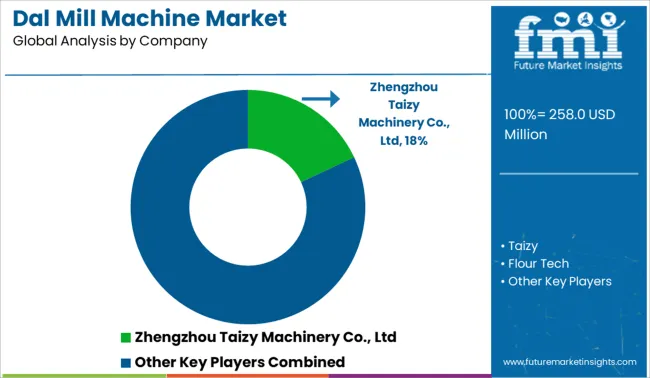
Key providers of dal mill machines include Zhengzhou Taizy Machinery Co., Ltd, HiTech Taizy, Flour Tech, Rising industries, Mill Master Machinery Private Limited, SATAKE, Alvan Blanch Development Company, Savco Sales, Pushpak, Deccan Farm Equipment.
These players are leveraging strategies such as new product launches, mergers, acquisitions, partnerships, and collaborations to increase their sales and stay relevant in the global space. For instance,
| Attribute | Details |
|---|---|
| Estimated Market Size (2025) | USD 258.0 million |
| Projected Market Size (2035) | USD 336.8 million |
| Anticipated Growth Rate (2025 to 2035) | 2.7% CAGR |
| Forecast Period | 2025 to 2035 |
| Historical Data Available for | 2020 to 2025 |
| Market Analysis | USD Million for Value and Units for Volume |
| Key Regions Covered | North America; Latin America; Europe; Asia Pacific; Oceania; Middle East & Africa (MEA) |
| Key Countries Covered | The USA, Canada, Mexico, Germany, The UK, France, Italy, Spain, China, Japan, India, South Korea, Australia, Brazil, Argentina, South Africa, UAE |
| Key Segments Covered | Product Type, Mode of Operation, Motor power, Application, Region |
| Key Companies Profiled | Zhengzhou Taizy Machinery Co., Ltd; Taizy; HiTech; Rising industries; Mill Master Machinery Private Limited; SATAKE; Deccan Farm Equipments; Alvan Blanch Development Company; Savco Sales; Puspak |
| Report Coverage | Market Forecast, Company Share Analysis, Competitive Landscape, DROT Analysis, Market Dynamics and Challenges, and Strategic Growth Initiatives |
The global dal mill machine market is estimated to be valued at USD 258.0 million in 2025.
The market size for the dal mill machine market is projected to reach USD 336.8 million by 2035.
The dal mill machine market is expected to grow at a 2.7% CAGR between 2025 and 2035.
The key product types in dal mill machine market are combined dal milling, mini dal milling and tractor operated dal milling.
In terms of motor power, 7.5 hp segment to command 36.8% share in the dal mill machine market in 2025.






Full Research Suite comprises of:
Market outlook & trends analysis
Interviews & case studies
Strategic recommendations
Vendor profiles & capabilities analysis
5-year forecasts
8 regions and 60+ country-level data splits
Market segment data splits
12 months of continuous data updates
DELIVERED AS:
PDF EXCEL ONLINE
Bimodal Identity Management Solutions Market Size and Share Forecast Outlook 2025 to 2035
Chordal Suture Systems Market Size and Share Forecast Outlook 2025 to 2035
Standalone Three Phase PV Inverter Market Size and Share Forecast Outlook 2025 to 2035
Standalone PV Inverter Market Size and Share Forecast Outlook 2025 to 2035
Colloidal Selenium Nanoparticles Market Size and Share Forecast Outlook 2025 to 2035
Colloidal Silver Market Report - Trends, Innovations & Forecast 2025 to 2035
Colloidal Metal Particles Market - Growth & Demand 2025 to 2035
Colloidal Silica Market Demand & Trends 2025 to 2035
Colloidal Alumina Market Growth - Trends & Forecast 2025 to 2035
Multimodal Chromatography Columns Market
Multi-Modal Biometric Cabin Sensors Market Analysis - Size, Share, and Forecast Outlook 2025 to 2035
Quadripodal Implants Market
Medical Germicidal Lamps Market Analysis - Size and Share Forecast Outlook 2025 to 2035
Demand for Colloidal Silver in EU Size and Share Forecast Outlook 2025 to 2035
Automotive Multimodal Interaction Development Market Size and Share Forecast Outlook 2025 to 2035
Millet Market Size and Share Forecast Outlook 2025 to 2035
Mill Pulverizer Market Size and Share Forecast Outlook 2025 to 2035
Mill Mixer Market Size and Share Forecast Outlook 2025 to 2035
Millimeter Wave Technology Market Size and Share Forecast Outlook 2025 to 2035
Millet Flour Market Analysis by Pearl Millet, Finger Millet, Foxtail Millet, Proso Millet, Kodo Millet, and Others Through 2035

Thank you!
You will receive an email from our Business Development Manager. Please be sure to check your SPAM/JUNK folder too.
Chat With
MaRIA